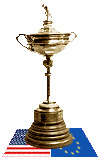The Ryder Cup
 The Ryder Cup is a biennial matchplay competition between professionals from the United States and Europe. Given the underlying rivalry between American and European golf as a whole, the event is intensely competitive and brings forth the depth of patriotism usually reserved for war time propaganda. It is without doubt the highlight of the golfing calendar.
The Ryder Cup is a biennial matchplay competition between professionals from the United States and Europe. Given the underlying rivalry between American and European golf as a whole, the event is intensely competitive and brings forth the depth of patriotism usually reserved for war time propaganda. It is without doubt the highlight of the golfing calendar.
From as early as 1921, there is a history of professionals teams from opposite sides of the Atlantic competing against one another. However, the Ryder Cup formally instituted the competition in 1926.  It takes it's name from Englishman Samuel Ryder who made his fortune by pioneering the sale of seeds in small packets. Ryder was a late inductee into golf after being advised to take up the game by his doctor. Concerned at the American domination of the Open by players such as Bobby Jones, Ryder set about promoting the professional game in Britain. He sponsored Abe Mitchell, then Britain's most promising golfer, in the hope that by relieving him of his club duties, he could practice and become a great British champion. Ryder later approached the PGA with his proposal for a biennial tournament between professionals from the US against those from Great Britain and Ireland. The US team was to be selected by the USGA. The Ryder Cup trophy is believed to have been made by Mappin & Webb of Sheffield, England with Abe Mitchell the model for the golfer on top.
It takes it's name from Englishman Samuel Ryder who made his fortune by pioneering the sale of seeds in small packets. Ryder was a late inductee into golf after being advised to take up the game by his doctor. Concerned at the American domination of the Open by players such as Bobby Jones, Ryder set about promoting the professional game in Britain. He sponsored Abe Mitchell, then Britain's most promising golfer, in the hope that by relieving him of his club duties, he could practice and become a great British champion. Ryder later approached the PGA with his proposal for a biennial tournament between professionals from the US against those from Great Britain and Ireland. The US team was to be selected by the USGA. The Ryder Cup trophy is believed to have been made by Mappin & Webb of Sheffield, England with Abe Mitchell the model for the golfer on top.
In 1926, the first Ryder Cup was played at Wentworth, Surrey. Britain and Ireland were represented by Abe Mitchell and George Duncan. The US side was represented by Walter Hagen and Jim Barnes. The result was a thrashing victory of 13 - 1 to the British and Irish team.
Although the Ryder Cup is an important event today, it was not taken very seriously by the Americans. On the whole, and with some justification, they believed that the standard of golf in the British Isles was far below that of America and therefore did not consider Europeans as worthy opponents. On many occasions, whether due to politics or arrogance, the Americans have not always selected their best golfers. Even so, with players like Snead, Sarazen, Hogan, Palmer, Trevino, Nicklaus and Watson, the Americans have dominated the event since their first victory in 1927. There was a brief moment of glory in 1957 when the British and Irish captained by Welshman Dai Rees brought the cup back to the British Isles.
Since the revitalisation of European golf in the early 1980s with players like Ballesteros, Faldo, Langer and Lyle and the inclusion of players from the European Continent into the European squad, the event has become truly competitive. The Americans seem to have a boundless supply of first rate golfers while the Europeans has perhaps a handful. Nevertheless, that is enough to muster an excellent Ryder Cup squad to make the event the wonderful competition that it is.

